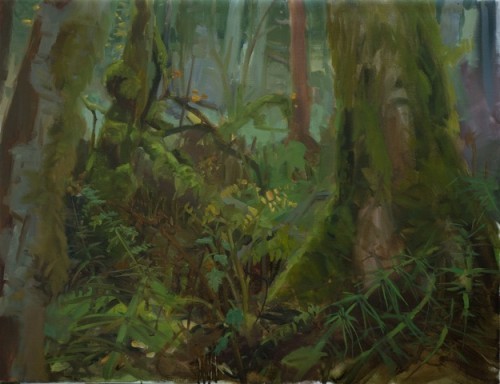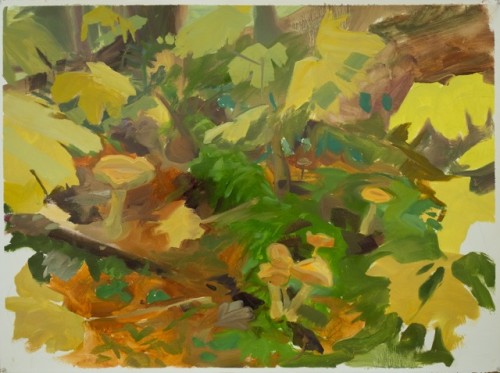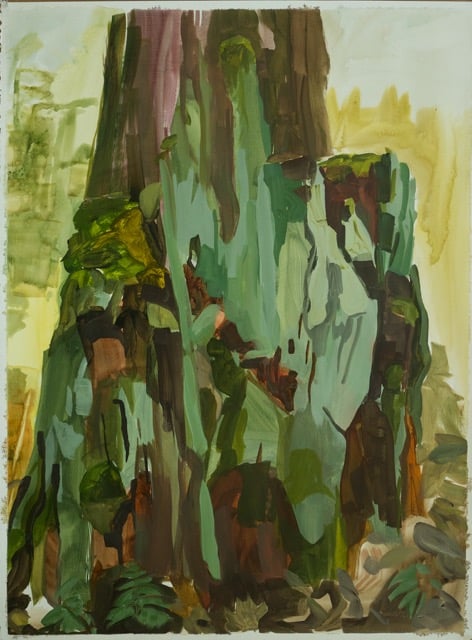Kristin Musgnug: Artist in Residence

By Kristin Musgnug
I am a landscape painter whose goal is to make paintings of the kind of places that don’t usually show up in landscape paintings – places that are not conventionally beautiful. While I thoroughly enjoyed the extraordinary beauty of the North Cascades Environmental Learning Center’s surroundings, it was a particular challenge to find places that evoked other responses.
My project while at theEnvironmental Learning Center involved close up painting of the forest floor, particularly in the lush undergrowth of old, wild forests. This project’s emphasis on intact, mostly un-interfered-with location represents a bit of a departure for me. For years my work has investigated the relations between humans and the natural world by painting in places where the results of this interaction were visible. Much of my work has been generated by considering such questions as: how our attitudes towards nature affect our actions towards it, how and why we shape the environment, and how we in turn are shaped by it. To do this I have often focused on landscapes shaped by a particular type of land use, such as campgrounds, parks, gardens, logged forests, parking lots and miniature golf courses.

Recently, while working on a previous project related to invasive plant species, I could not help but notice the enormous contrast between the low diversity of species in the degraded environments where invasive species were found, and the rich tapestry of life forms in intact ecosystems. Old growth forests were particularly compelling to me. At the same time I became interested in wild mushrooms and spent a great deal of time wandering around in the forest staring at the ground. The more closely I looked, the more intriguing the forest floor became. The community of mosses, ferns, lichens, fungi and wildflowers, along with countless little creatures going about their lives, resembled nothing so much as a neighborhood.
The Arkansas Ozarks where I live are considerably drier than the western Cascades, and supports a more sparsely populated forest floor community. I had never been to the North Cascades before, but I was drawn to the lush under story created by the wet climate of the Pacific Northwest. In particular, I was interested in experiencing the extraordinary abundance of fall fungi here.
I spent my first day just wandering around, taking it in, before settling down to paint. Painting on location is crucial to my process, both to record information and to establish an empathetic connection to the place. My on-site paintings are usually relatively quick, just one or two sessions, and become the basis for larger paintings made in my home studio over a longer period of time.

Late October was a beautiful time at the ELC. The fall foliage of big leaf maples and other deciduous trees drenched the forest in a dreamy golden light. Mushrooms were coming up all over the place. The forest floor was a riot of color. I painted mushrooms coming up as the leaves of devils club were falling down, moss and lichens growing on ancient snags, bracket fungi jostling for space on a dead alder, lipstick lichens colonizing a mini-mountain, horsetails falling over in the morning mist.
I joined an Institute mushroom workshop in which we spent the day collecting and studying mushrooms down by Baker Lake. One cool foggy morning I hiked up to Pyramid Lake, which was too beautiful for me to paint, but compelling nonetheless. The ELC staff and graduate students also had plenty of interesting conversations with me during my time there.
While I was at the ELC for just ten days, and left wishing I’d come for longer. I hope some other project will bring me back in the future.
Kristin Musgnug is faculty in the University of Arkansas’ Art Department. North Cascades Institute believe that creativity and the arts improve education and we invite working artists, writers and naturalists from a broad spectrum disciplines to apply for our Creative Residency program at the North Cascades Environmental Learning Center. The goal of the Institute’s Creative Residency program is to bring creative people working in a wide variety of genres — poets, naturalists, painters, essayist, dancers, novelists, photographers, sculptors, teachers, printmakers, memoirists, researchers and others using the creative process to explore and interpret the natural world — to the Environmental Learning Center to pursue their art and demonstrate the many forms that creativity takes. Learn more at www.ncascades.org/creative-residencies.

